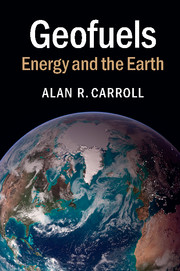Book contents
- Frontmatter
- Contents
- Acknowledgments
- 1 Introduction
- 2 The Living Earth
- 3 Warmed from Above: Solar Energy
- 4 Wind, Water, and Waves: Energy from the Fluid Earth
- 5 Covered in Green: Biofuels Basics
- 6 Fossil Farming: The Geologic Underpinnings of Biofuels
- 7 The Light of an Ancient Sun: Fossil Fuel Origins
- 8 Digging for Daylight: Coal and Oil Shale
- 9 Skimming the Cream: Conventional Oil and Gas
- 10 Stuck in the Mud: Fossil Fuels That Fail to Flow
- 11 Petrified Petroleum: Oil Sand and Gas Hydrate
- 12 Water, Water, Everywhere
- 13 Primordial Power: Geothermal and Nuclear
- 14 Out of Sight, Out of Mind: Geologic Waste Disposal
- 15 How Long Is Forever? Energy and Time
- 16 Conclusions
- Index
- References
4 - Wind, Water, and Waves: Energy from the Fluid Earth
Published online by Cambridge University Press: 05 March 2015
- Frontmatter
- Contents
- Acknowledgments
- 1 Introduction
- 2 The Living Earth
- 3 Warmed from Above: Solar Energy
- 4 Wind, Water, and Waves: Energy from the Fluid Earth
- 5 Covered in Green: Biofuels Basics
- 6 Fossil Farming: The Geologic Underpinnings of Biofuels
- 7 The Light of an Ancient Sun: Fossil Fuel Origins
- 8 Digging for Daylight: Coal and Oil Shale
- 9 Skimming the Cream: Conventional Oil and Gas
- 10 Stuck in the Mud: Fossil Fuels That Fail to Flow
- 11 Petrified Petroleum: Oil Sand and Gas Hydrate
- 12 Water, Water, Everywhere
- 13 Primordial Power: Geothermal and Nuclear
- 14 Out of Sight, Out of Mind: Geologic Waste Disposal
- 15 How Long Is Forever? Energy and Time
- 16 Conclusions
- Index
- References
Summary
The wind goeth toward the south, and turneth about unto the north; it whirleth about continually, and the wind returneth again according to his circuits. All the rivers run into the sea; yet the sea is not full; unto the place from whence the rivers come, thither they return again.
Book of Ecclesiastes, King James versionIf you don't like the weather around here, just wait 5 minutes and it will change.
Universally expressed local opinion about all weather, everywhereSunlight is abundant, free, and, from the human perspective, eternal. However, as noted in the previous chapter, sunlight is not particularly strong in its natural state, and requires artificial concentration if it is to do any really ambitious work. Fortunately when it comes to concentrating sunlight, nature has already taken the lead. This is true because sunlight causes dramatically unequal heating of the Earth's surface at different latitudes, between land and sea, and between night and day. Uneven heating sets air and water into motion, leading to a complex and sometimes violent sequence of events that act to spread warmth more evenly across the globe. These events never reach an end, however, because the Sun continues to shine and the Earth never stands still. We therefore experience perpetually dynamic weather.
Wind can thus be thought of as solar energy converted into motion. The interaction between wind currents and surface topography help to focus this flow, resulting in localized areas where surface wind speeds exceed the regional average. An opportunity therefore exists for the wind to do real work, if we are somewhat selective about where and when that work is to be done. This is of course no great revelation; wind has propelled sailing ships and turned windmills since the dawn of recorded history. However, wind has also developed a well-deserved reputation for inconstancy. Some days it arrives with a destructive vengeance that precludes any peaceable use; other days it fails to show up at all.
- Type
- Chapter
- Information
- GeofuelsEnergy and the Earth, pp. 57 - 79Publisher: Cambridge University PressPrint publication year: 2015



